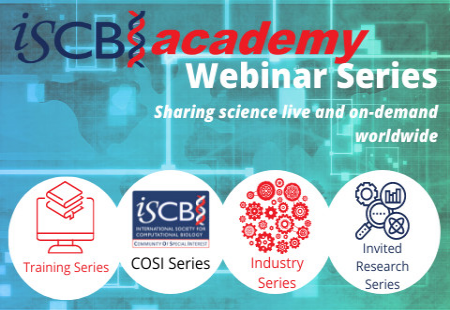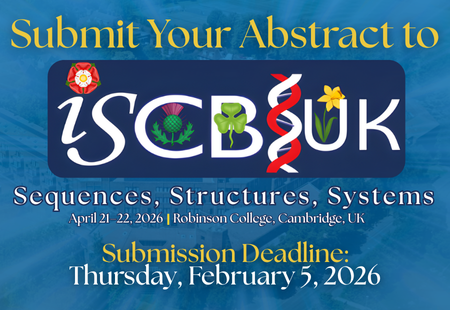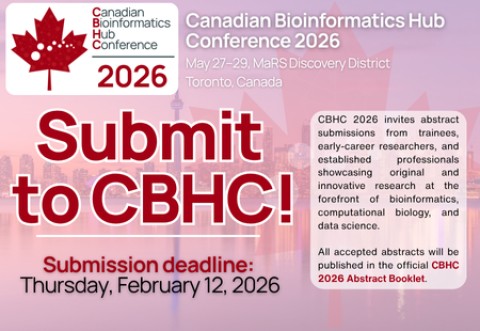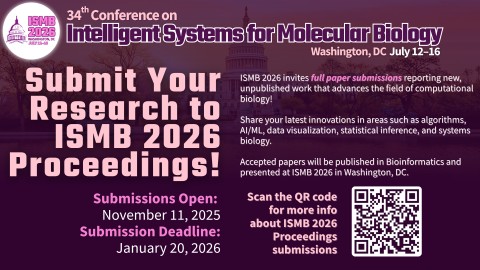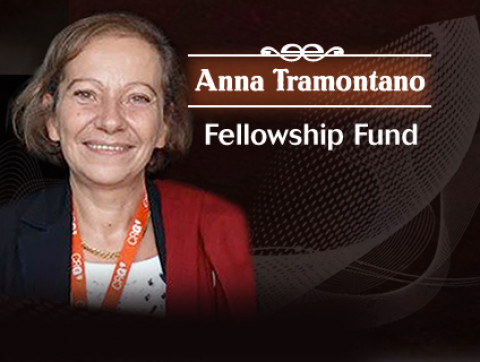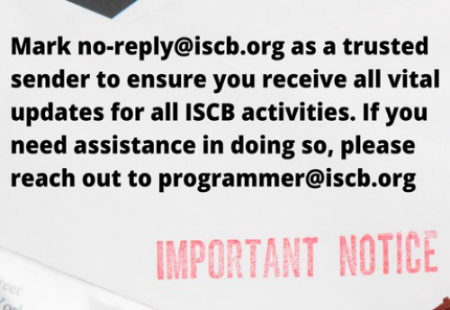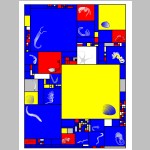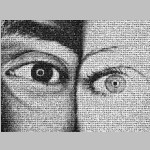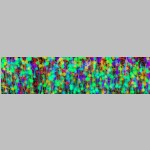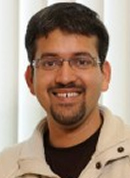 |
2018 ISCB Innovator Award
M. Madan Babu
|
2018 ISCB Innovator Award: M. Madan Babu
The ISCB Innovator Award recognizes an ISCB scientist who is within two decades of having completed his or her graduate degree and has consistently made outstanding contributions to the field of computational biology. The 2018 winner is Dr. M. Madan Babu, Programme Leader at the MRC Laboratory of Molecular Biology, Cambridge, UK. Madan received his award and delivered a keynote presentation at the 2018 International Conference on Intelligent Systems for Molecular Biology in Chicago, Illinois, held on July 6-10, 2018.
M. MADAN BABU: PEERING INTO THE REALM OF REGULATION
M. Madan Babu is the head of the Regulatory Genomics and Systems Biology group at the MRC Laboratory of Molecular Biology, Cambridge, UK. His work focuses on understanding how cellular systems are regulated at different scales (molecular, systems, and genomic levels) and how this impacts genome evolution.
Madan grew up in Chennai, India and developed early interests in computer science and biotechnology. As a young child, he has vivid memories of his father bringing home a personal computer, and soon after he became interested in learning to program. He also remembers when his family first started using the internet, and recalled, “In the mid-90’s, we started having access to the Internet. This made a big difference in the days where access to information beyond textbooks was not readily available; so thanks to my father I had these opportunities early in my life.” Madan discovered biotechnology as a high school student, and attributes his lifelong interest in biology to the impact of his biology teacher, Dr. M.C. Aruna, who discussed foundational biological concepts with him, including how genetic information can be used to understand living systems. Madan went on to pursue a Bachelor of Technology (Biotechnology) degree at Anna University, Center for Biotechnology in Chennai, India. He first became of aware of computational biology during his first year undergraduate research internship, at which time he was exposed to the work of Cyrus Chothia and Arthur Lesk in a course on protein structure. He became fascinated with this research area and then delved into seminal papers on computational genomics, protein engineering, and structural bioinformatics. As an intern, Madan pursued undergraduate research under the guidance of Prof. Balaram and Prof. K. Sankran, and saw this a key turning point in his career path. He recollected, “We started applying methods from computer science to study protein sequences and structures. For the first time, I experienced how to define a scientific problem, develop computational methods to solve it, and write up and defend the findings for publication. This really got me excited and that was when I decided that I would like to pursue a career in computational biology.”
Madan recognizes that his interest in computational biology was fostered by his ability to access publicly-available protein and genomic data on his own computer, as well as the open access he had to lecture materials, methods and algorithms from computational biologists spanning the globe. He said, “I cannot forget the day when I wrote an email to RCSB from India and received a 5-part CD-ROM with coordinate data for all protein structures. Being able to look at protein structures using RASMOL from home and writing FORTRAN programs to analyze structures as an undergraduate student was one of the most exciting experiences that really captured my interest in the field.” Madan left India in 2001 to pursue his PhD in computational genomics at the MRC Laboratory of Molecular Biology and Trinity College, University of Cambridge, UK under the guidance of Dr. Sarah Teichmann. His PhD research explored various aspects of gene regulatory networks, and marked the beginning of a very fruitful mentorship under Teichmann. Madan carried out his postdoctoral training at the National Center for Biotechnology Information, NIH in Bethesda, MD, USA under the guidance of Dr. L. Aravind, during which time he learned the importance of having broad interests in diverse subject areas as well as critically analyzing the complexity of biological systems at every possible level of detail. After a brief but extremely productive postdoctoral fellowship, Madan became a group leader at the age of 26 of the Regulatory Genomics and Systems Biology Group at the MRC Laboratory of Molecular Biology in 2006. As a PI, he has come to appreciate how his team of scientists can work together to tackle scientific questions on a much larger scale and shed new light on long-standing, fundamental questions. He said, “One of the things that I really enjoy about the field of computational biology is that you really integrate knowledge from various disciplines-- biology, statistics, computer science, mathematics, physics and chemistry. This means our lab is an amalgamation of people across disciplines that are really passionate about using interdisciplinary approaches to solve the problems they are working on.”
Madan’s group currently focuses on several areas of research, including studies on G-protein coupled receptors (GPCRs), a protein family involved in almost every aspect of human physiology and targeted by numerous drugs. Madan’s group is also using a combination of computational and experimental approaches to discover which parts of unstructured protein regions are functional and understand what makes them functional. His group is interested in applying developments in statistical learning and advances in large-scale genome sequencing to better understand natural variation in the human population as well as gain insight into how genomic variation impact rare and common diseases.
Madan is greatly honored to be selected as the recipient of the 2018 ISCB Innovator Award. He is grateful for his academic mentors and colleagues, including Sarah Teichmann, L. Avarind, Cyrus Chothia, Michael Levitt, Veronica Van Heyningen, Eugene Koonin, Stephen Michnick, Richard Kriwacki, Uri Alon, Arthur Lesk, Alexey Murzin, Julian Gough, Daniela Rhodes, Gebhard Schertler, Peter Wright, Keith Dunker, Janet Thornton, Tom Blundell and Venki Ramakrishnan, who have inspired him through their work and/or provided him valuable advice at various stages of his career. He is also appreciative of his past and present group members, and the MRC Laboratory of Molecular Biology for the freedom to develop new skills and take risks in pursuing research that pushes scientific boundaries. Last but not least, he is grateful to his parents, sister, wife and 2-year old son for their love, support and inspiration.
_______________________________________________________
Full bibliographical articles profiling the award recipients please see the ISMB 2018 focus issue of the ISCB newsletter as well as the ISCB Society Pages in PLOS Computational Biology and OUP Bioinformatics. Later this year, articles will be publish in F1000 Research ISCB Community Journal.
top
>> Return to Innovator Awards page
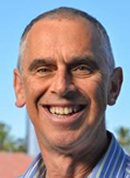
|
2018 Outstanding
Contribution to ISCB
Russ Altman
|
2018 Outstanding Contribution to ISCB:
Russ Altman
The Outstanding Contributions to ISCB Award was introduced in 2015 to recognize Society members who have made lasting and beneficial contributions through their leadership, service, and educational work, or a combination of these areas. Russ Altman, Kenneth Fong Professor and Professor of Bioengineering, of Genetics, of Medicine (General Medicine Discipline), of Biomedical Data Science, and, by courtesy, of Computer Science, is the 2018 winner of the Outstanding Contributions to ISCB Award and was recognized at the 2018 Intelligent Systems for Molecular Biology (ISMB) meeting in Chicago, Illinois held on July 6 - 10, 2018.
Altman’s years of dedicated service to ISCB began when he attended the very first ISMB meeting in 1993. As a brand new faculty member, he remembered how he felt at home at ISMB, surrounded by a community of scientists also interested in computational biology and bioinformatics. Altman’s enthusiasm at this first ISMB meeting led him to help organize the next ISMB meeting. He recalled, “It became clear that there was no obvious “host” for ISMB 1994, so I volunteered to host it at Stanford, where we had a lovely meeting with a couple of hundred people. We had some extra money after paying our bills, so we wanted to send the money to wherever ISMB 1995 was going to be (UK). For the first few years, this is how ISMB worked—the organizers from one year would send the leftover funds as a seed for the next ISMB. There was no organization, and as the size of the leftover check increased, we started getting nervous and realized we needed to create a legal entity. ”ISCB was born at ISMB 1997 in Halkidiki, Greece, where organizers of former ISMB meetings and others sat at dinner on the beach and planned the society and figured out how to incorporate it. Altman has warm recollections of that historic gathering and said, “There are pictures of that great dinner and group, and I treasure the memory of that meeting.”
Altman has enjoyed serving ISCB at all levels since its inception, from work on the Publications Committee and as a conference organizer, to his tenure on the ISCB Board of Directors (1997-2005) and as ISCB President (2002-2005). Altman’s early work on the Publications Committee included applying for PubMED to index the ISMB proceedings, which was a critical step in helping ISCB members receive academic credit for their conference papers. Altman also helped negotiate the agreement to have Bioinformatics named as an official ISCB journal. Beyond ISMB, Altman has been an organizer of the Pacific Symposium on Biocomputing, and has facilitated the relationship between this conference and ISCB.
As computational biology and bioinformatics have grown into stand-alone fields, Altman has made many critical scientific contributions through his research. Altman and his research group have developed numerous computational tools that address problems in basic biology and medicine, with a particular interest in understanding drug responses. His work has included studies of structure-function relationships in macromolecules, understanding RNA structure and folding, and assessing drug responses at the molecular, cellular, organismal, and population levels.
Altman believes that it is critical to bring awareness to the greater scientific community that computational biologists and bioinformaticians are more than just great collaborators, but they also lead major research projects. He considers service to ISCB as a way established PIs, junior faculty, and trainees can help bring about this awareness to advance the field. Altman considers ISCB to be a community that provides both valuable service opportunities and sources of mentorship and collaboration for scientists.
Altman’s dedication to the field computational biology has been recognized by his election as an ISCB Fellow (2010), as well as with numerous other honors, including election as a member of the National Academy of Medicine (formerly the Institute of Medicine, 2009) and a Fellow of the American Association for the Advancement of Science (2014). Altman has also worked as an editor and reviewer for numerous scientific journals, including serving as Co-Editor-in-Chief of the Annual Review of Biomedical Data Science.
Altman’s many years of service to ISCB have been critical to the very formation and evolution of the Society from its infancy as a small meeting to the globally recognized professional organization that it is today.
_______________________________________________________
Full bibliographical articles profiling the award recipients please see the ISMB 2018 focus issue of the ISCB newsletter as well as the ISCB Society Pages in PLOS Computational Biology and OUP Bioinformatics. Later this year, articles will be publish in F1000 Research ISCB Community Journal.
top
>> Return to Outstanding Contributions to ISCB
ISCB Student Wikipedia Competition
ISCB Student Wikipedia Competition announcement 2025-26
|
|
ISCB announces its 15th annual international competition to improve the coverage on Wikipedia of any topic relating to ISCB’s Bioinformatics Core Competencies.
A key component of the ISCB's mission to further the scientific understanding of living systems through computation is to communicate this knowledge to the public at large. Wikipedia has become an important way to communicate all types of science to the public and the ISCB aims to further its mission by increasing the quality of Wikipedia coverage of related topics, and by improving accessibility to this information via Wikipedia.
The competition is open to students and postdocs, either as individuals or as groups.
|
|
The prizes for the best Wikipedia articles in any language provided by the ISCB will be:
• 1st prize - $500 (USD) and 1 year membership to the ISCB.
• 2nd prize - $250 (USD) and 1 year membership to the ISCB.
• 3rd prize - $150 (USD) and 1 year membership to the ISCB.
|
| KEY DATES |
| Competition entries open |
05 September 2025 |
| Competition ends |
01 May 2026 |
| Judging panel shortlisting |
May-June 2026 |
| Announcement of winners |
July 2026 (at ISMB/ECCB 2026) |
|
|
| To learn more, click here. To enter the competition, click here. |
|
top
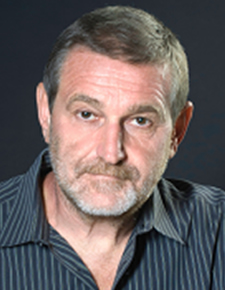 |
2017 ISCB
Accomplishment by a
Senior Scientist Award
Pavel Pevzner
|
2017 ISCB Accomplishment by a Senior Scientist Award: Pavel Pevzner
The International Society for Computational Biology (ISCB) recognizes an established scientist each year with the Accomplishment by a Senior Scientist Award for significant contributions he or she has made to the field. This award honors scientists who have contributed to the advancement of computational biology and bioinformatics through their research, service, and education work. Pavel Pevzner, PhD, Ronald R. Taylor Professor of Computer Science and Director of the NIH Center for Computational Mass Spectrometry at University of California, San Diego, has been selected as the winner of the 2017 Accomplishment by a Senior Scientist Award.
The ISCB awards committee, chaired by Dr. Bonnie Berger of the Massachusetts Institute of Technology, selected Pevzner as the 2017 winner.
_______________________________________________________
PAVEL PEVZNER: IN SEARCH OF LIFE’S PERFECT PUZZLES
Pevzner was born in Kursk, Russia, and spent his childhood in the city of Murom, which was a hub of the Soviet electronics industry. His father was an electrical engineer and his mother was a teacher, but he admits that his early education got off to a rocky start. He described himself as a poor student who was more interested in having fun, but around age 10, he grew more interested in books.1 Pevzner’s interest and abilities in mathematics were soon recognized, and at age 14 he was sent to the Boarding High School at Moscow State University, founded by world-renowned mathematician Andrey Kolmogorov, for children gifted in math and physics. In spite of Pevzner’s rigorous high school math studies, he had difficulty getting into Moscow State University because of the anti-semitic admission policies aimed at ethnic Jews.2
As an undergraduate, Pevzner studied at the Russian Institute of Railway Engineers, which was known for its applied mathematics program. He did well throughout his course of study and published a number of papers on discrete mathematics as an undergraduate. In 1985, he joined a bioinformatics lab at Institute of Genetics of Microorganisms VNIIGENETIKA, and received his Ph.D. in Mathematics and Physics in 1988 from the Moscow Institute of Physics and Technology.
Pevzner was completing his graduate work during the era of “Perestroika” and “Glastnost,” and for the first time in decades, scientists were being granted permission to travel abroad and were even told that the government would pay for their travels. Pevzner jumped on this opportunity and notified the Russian government that he wanted to work with Mike Waterman at the University of Southern California (USC), a pioneer in the field of bioinformatics and 2006 ISCB Accomplishments by a Senior Scientist Award winner. In 1989, Pevzner reached out to Waterman personally, not quite trusting that his request to the government would be enough to facilitate his travels (it was never granted). During their correspondence, Waterman sent him an open problem, which Pevzner ended up solving. Waterman was surprised that someone had solved this problem and eventually invited him to pursue postdoctoral work in his lab. Pevzner spent two years as a postdoc with Waterman at USC.
In 1992, Pevzner established himself as an independent researcher and started his lab in the Department of Computer Science at Pennsylvania State University. Three years later he returned to USC as a professor in the Department of Mathematics. In 2000, he moved to San Diego and was named Ronald R. Taylor Chair Professor of Computer Science at the University of California, San Diego (UCSD). In 2006, he was named a Howard Hughes Medical Institute Professor.
Pevzner’s research interests span the field of bioinformatics and his work has been guided by applying algorithmic ideas to bioinformatics problems. Pevzner has made significant contributions to a wide array of subfields, including genome assembly, understanding how genome rearrangements influence evolution, and developing new algorithms for sequencing antibodies and antibiotics using mass spectrometry. He continues to be fascinated and amazed by scientific discovery, and he explained, “The most surprising thing for me was a realization that dominant biological theory often falls apart when new data and new methods to analyze them become available. Three times in my career I had to refute the biological theories that I worked on: the Master Alu theory of repeat evolution, the NME theory that connects the N-terminal Methionine Excision and protein half-lives, and the Random Breakage Theory of chromosome evolution.”
In this era of abundant genome data, Pevzner is currently interested in reconstructing the detailed evolution of the human genome, down to each new repeat and rearrangement that affected the genome, by using hundreds of primate genomes that will be sequenced in the near future. In a more practical domain, Pevzner’s other goal is to develop a computational approach to antibiotics discovery, a problem of great importance due to emerging antibiotics resistance. He describes antibiotics discovery as one of the last bastions of modern biology that remains barely touched by bioinformatics.
Beyond Pevzner’s academic contributions, he has served the computational biology community in many ways. Seventeen years ago, he helped launch RECOMB (Conference in Research in Computational Molecular Biology) together with Waterman and Sorin Istrail. He has served as a member of numerous editorial boards in the fields of computational biology and computer science.
Throughout his career, Pevzner has mentored many students; 22 of his former graduate and postdoctoral trainees are now professors at various universities. He has seen significant changes to the way he teaches his undergraduate courses along the way. He explained, “The way I teach my undergraduates has completely changed: I haven’t given a traditional classroom lecture in three year now. I feel that traditional 1000-year old educational technology (classroom lecture) is coming to its end and will soon be substituted by more efficient “Intelligent Tutoring Systems.” My goal in recent years was to develop the first such system for bioinformatics that will be launched in Spring 2017 on edX.”
Pevzner is humbled by his selection as the winner of the 2017 ISCB Accomplishment by a Senior Scientist Award – he acknowledges that he did not earn this recognition alone. He said, “This award really goes to my teachers and my students and postdocs over the last quarter of a century.”
1 www.scientific-computing.com/feature/life-puzzle-solver
2 www.npr.org/2014/03/28/295789948/the-real-problem
top
>> Return to List of Senior Scientist Recipients
 |
Picture: 2012 Accomplishment By A Senior Scientist Award
Prize Winner,
Gunnar von Heijne.
Photo by Max Brouwer |
2012 ISCB Accomplishment by a Senior Scientist Award Winner - Gunnar von Heijne
Perhaps it all began with the French lessons. As a a young PhD student in theoretical physics at the Royal Institute of Technology (KTH) in Stockholm, Gunnar von Heijne decided, on whim, to brush up on his rusty, schoolboy French. He took a few lessons and also subscribed to the French popular science magazine La Recherche.
Flicking through its pages, he came across a short article on protein secretion and the signal hypothesis, the mechanism that describes the way secretory proteins cross a membrane.
At the time, the late-1970s, very little was known about this process, but some ideas were beginning to emerge. For example, it was thought that a so-called signal peptide---a short chain of amino acids---at the end of the protein carried the signal that determined how the proteins are transported out of the cell.
The article confused him, however. It showed a diagram of a hydrophobic signal peptide squeezing through the similarly hydrophobic membrane. "That didn't make sense to me. The hydrophobic peptide ought to become anchored in the membrane,"he says.
The puzzle piqued his interest. He solved it by calculating the energetics of a polypeptide chain passing through lipid bilayer, which he published in 1979. This work by a theoretician created ripples in a field dominated by experimentalists.
And so began the career for which he now receives the Accomplishment by a Senior Scientist Award from the International Society for Computational Biology (ISCB). "Gunnar is one of the big stars of our field,"says Burkhard Rost, president of the ISCB. "He is one of the few who completely change the field using computational methods."Polypeptide energetics was only the start, however.
By the early 1980s, molecular biologists had begun to determine the sequence of amino acids in the signal peptides from different proteins. However, little had been done to study the properties of signal peptide sequences as a group.
von Heijne changed this. He began comparing the sequences, looking for recurring patterns that might help to identify them. "I looked at 20 to 30 signal peptides. Once you did that, some clear patterns emerged that had not been seen before,"he says.
He found that small, uncharged amino acids tended to occupy certain positions in signal peptide chains, the -3 and -1 positions. It is at this site that the signal peptide is later cleaved from the protein once it has passed through a biomembrane. This pattern has since become known as the (-3, -1)--rule.
"Nowadays you would say this was a very trivial bioinformatics study,"he says modestly. However, this was an important discovery and von Heijne's paper has since become one of the most highly cited in the field.
He then used the newly discovered patterns to make predictions about proteins. For example, it became possible to create an algorithm that would take a protein sequence and predict whether it had a signal peptide at the end.
Initially, that was not very useful. When molecular biologists sequenced a gene or messenger RNA, they generally knew what they were working on; whether it would have a signal peptide on the end or not.
But that changed when sequencing became faster and biologists started to sequence things they didn't know much about. "The algorithms have continually improved and are now extremely useful,"he says.
Secretory proteins have to move across a lipid bilayer through a molecular machine called a translocon. The signal peptide guides the ribosome that makes the protein, towards the translocon. This triggers the opening of this protein-conducting channel through the membrane.
But other types of protein only make the journey partway, becoming embedded half in and half out of the membrane. These so-called membrane proteins use the same translocon machinery as the secretory proteins. "So it was a natural step to start looking at these membrane proteins next,"says von Heijne.
The part of the protein that ends up in the membrane is very different to the parts outside exposed to water. This transmembrane section must be much more hydrophobic. So the trick to predicting which parts of a protein become embedded in the membrane is to look for the segments that are most hydrophobic.
Once you know the transmembrane segments, an interesting problem is to determine how the protein becomes woven into the membrane. For example, if it has four hydrophobic sections, there are two ways in which it can be arranged in the membrane: with the termini pointing either in or out. But which orientation should the protein take?
"We discovered a very simple principle that determines this,"he says. The regions that connect the transmembrane segments contain positively charged amino acids, which give them an electric potential. The simple principle is that the segments with the greatest number of positive charges end up inside the membrane, an idea that has since become known as the "positive inside rule".
"This is very important work and provides some of the best data on membrane proteins,"says Alfonso Valencia, chair of the ISCB awards committee.
In the late 1980s, von Heijne began to realise that he could gain significant insight into these and other problems by doing experiments rather than just theory work. So he set up his own lab. "I trained as a chemist so I wasn't a complete novice in a wet lab,"he says.
This first idea was to see whether it was possible to make proteins that inserted "upside-down"into the membrane. He could show that by changing the location of the positively charged amino acids in a protein, it is possible to make it take up the opposite orientation.
This link between his theoretical and practical work has been important for him. Bioinformatics studies often throw up patterns that may or may not have biological relevance. "The only way to determine whether they are important is to do the experiments,"he says.
"It's hard to overstate the significance of von Heijne's work. Membranes and transmembrane proteins are the gates and gatekeepers to our cells; they determine what gets in and what stays out,"explains Rost. "That's why around two-thirds of drugs target membrane proteins."Understanding the structure of transmembrane proteins provides crucial insight into how cells work and is also useful for future drug development. "That's why the methods developed by Gunnar are so important,"says Rost.
To continue his work, von Heijne set up the Stockholm Bioinformatics Centre at the beginning of the millennium. And today, von Heijne runs the Centre for Biomembrane Research in Stockholm, where he has brought together computational, modelling, and experimental groups. Few places can boast the same breadth of experience under one roof.
Throughout this time, von Heijne has maintained an impressive work--life balance as a scientist, a husband, and a father. He says that's been possible, at least in part, because he was working in a new field with few competitors. "I never felt stressed that we'd be scooped. I work hard but not crazily ."Others clearly admire his positive approach, which he combines with a relaxed attitude. "He also looks ten years younger than he has any right to!"says one envious colleague.
For a while in the 1980s, he spent half his time working as a science journalist for the Swedish National Radio. "You decide on Monday what you broadcast on Friday so there is immediate feedback, which has a good pulse to it,"he says.
But for von Heijne, doing science is more satisfying than reporting it. "Radio stories have a short half life; they're on air, then they're gone,"he says. "The rewards in science are greater and longer lasting."It's surprising how far schoolboy French can take you.
-
This article is excerpted from the May 2012 issue of PLoS Computational Biology. To link to the full journal article please visit www.ploscompbiol.org/article/info%3Adoi%2F10.1371%2Fjournal.pcbi.1002535
>>Return to List of ASSA Recipients
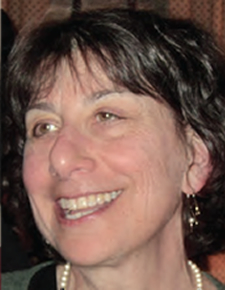
|
2017 Outstanding
Contribution to ISCB
Fran Lewitter
|
2017 Outstanding Contribution to ISCB:
Fran Lewitter
The Outstanding Contributions to ISCB Award was launched in 2015 to recognize individuals who have made lasting and valuable contributions to the Society through their leadership, service, and educational work, or a combination of these areas. Fran Lewitter is the 2017 winner of the Outstanding Contributions to ISCB Award and will be recognized at the 2017 Intelligent Systems for Molecular Biology (ISMB)/European Conference on Computational Biology meeting in Prague, Czech Republic being held from July 21-25, 2017.
Fran Lewitter completed her PhD in Human Genetics and Statistical Genetics at the University of Colorado Boulder. After completing postdoctoral work in Genetic Epidemiology at Harvard Medical School, she worked on the first five years of the GenBank project. Lewitter then worked in the Biology Department at Brandeis University in a number of capacities, including supporting molecular biology computing and being involved with their Genetic Counseling program. In 1994, she joined the Whitehead Institute for Biomedical Research in Cambridge MA. to run a bioinformatics core facility. For twenty years, she worked with and trained basic biomedical researchers who were doing sequencing or were using bioinformatics to gain a deeper understanding of different biological questions. She was later named the Founding Director of Bioinformatics and Research Computing and was given a larger staff as the demand for bioinformatics information grew in the late 1990s and early 2000s.
Lewitter’s first encounter with ISCB occurred when she attended ISMB 2001 in Copenhagen, Denmark, followed by a one-day satellite meeting, Workshop on Education in Bioinformatics (WEB). At the time, Whitehead did not have a large bioinformatics community, and she was in search of peers who were running bioinformatics core facilities and teaching bioinformatics to biologists. “One thing that attracted me to go [to ISMB] was the one day workshop on education and bioinformatics, since I was so heavily involved in educating people. I went to every meeting since then.” At ISMB 2002 in Edmonton, Lewitter helped organize an informal gathering of bioinformatics core facility managers, and this unique gathering spurred the organization of a mailing list, which became an invaluable resource for Lewitter and her peers as they faced challenges and questions unique to running a core facility.
Since her early encounters with ISCB, Lewitter has become a tireless advocate for bioinformatics education and training on behalf of ISCB. As a core facility director, she has offered her unique academic perspective and voice through her service on the ISCB Education Committee and as a member of the Board from 2008- 2017. Lewitter recognized the growing demand for bioinformatics training early in her involvement with ISCB, and she worked to strengthen ISCB’s role in supporting bioinformatics education and training by promoting the inclusion of bioinformatics education content in the main conference programs. To this end, she has organized Workshops on Education in Bioinformatics (WEB) at ISMB meetings since 2009, and she has helped build ISCB community activities including the CoBE COSI (Computational Biology Education Community of Special Interest). Lewitter’s leadership of the ISCB Education Committee helped unite the global bioinformatics education community through shared objectives and brought greater awareness of the committee’s work through tutorials and training opportunities offered at ISCB conferences. Lewitter recognizes that one of the most critical aspects of training is “to introduce biologists to bioinformatics vocabulary whether or not they would be using the primary bioinformatics tools.” This fosters better collaborations between bioinformatics experts and bench scientists and is necessary to facilitate the ongoing integration of bioinformatics into all aspects of biology.
Lewitter has been instrumental in bringing together ISCB and GOBLET (the Global Organization for Bioinformatics Learning, Education and Training) and coordinating activities by which these two organizations work together to further bioinformatics training on a global scale. She has advocated for the development and maintenance of bioinformatics education resources on ISCB webpages, and these electronic resources are valuable tools used by the global bioinformatics education community.
Lewitter has valued her membership in ISCB for providing her opportunities to “get to know innovative people.” She has especially appreciated meeting other core facility directors and managers. Lewitter said, “ It’s gratifying to hear I am doing the right thing, or other people have ideas that can help me or I can help them. It is good to talk to other people about issues of running a core facility, what courses to teach or what tools are the best to teach?” Despite having retired from Whitehead Institute three years ago, she enjoys her continued involvement in ISCB activities. She is also heartened by the rising generation of ISCB members who are involved with the ISCB Student Council. Lewitter hopes ISCB will continue to grow and thrive and is grateful for being recognized for her steadfast efforts to promote and further bioinformatics education.
top
>> Return to Outstanding Contributions to ISCB
THE 2021 ART IN SCIENCE COMPETITION
Submit Art Work
Find the beauty of science through art!
ISCB members attending the ISMB/ECCB 2021 are encouraged to showcase the artistic side of science by submitting to The Art in Science Competition!
Judges making up a select committee of each level of the ISCB membership will evaluate
for the following:
- Scientific significance to the field of bioinformatics
- Overall impression of the art / visual impact of the image
- Originality
*all submitters will be notified via email in July with the results.
The accepted works will be displayed ISMB/ECCB 2021.
The winning image will be announced during the virtual ISCB Town Hall and presented with a $200 USD prize, as well as be the feature cover image for the ISCB Fall Newsletter.
Submit your artwork today!
Deadline to Submit: June 15, 2021
Previous Image Contest Winners
top
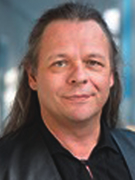 |
2016 Outstanding
Contribution to ISCB
Burkhard Rost
|
2016 Outstanding Contribution to ISCB:
Burkhard Rost
The Outstanding Contributions to ISCB Award was launched in 2015 to recognize individuals who have made lasting and valuable contributions to the Society through their leadership, service, and educational work, or a combination of these areas. Burkhard Rost is the 2016 winner of the Outstanding Contributions to ISCB Award and will be recognized at the 2016 Intelligent Systems for Molecular Biology (ISMB) meeting in Orlando, Florida on July 8-12, 2016.
Rost is the Alexander von Humboldt Professor and chair of bioinformatics and computational biology at the Technical University Munich. His research interests focus on using machine learning and artificial intelligence to predict the structures and functions of proteins and genes. Rost has served ISCB in numerous positions throughout his career, including being co-chair of the largest annual meeting in computational biology, Intelligent Systems in Molecular Biology (ISMB), during 2007 (Vienna), 2008 (Toronto), 2011 (Vienna), 2012 (Long Beach), and 2013 (Berlin).
Rost served as ISCB president from 2007-2014. When he assumed the leadership position, the Society was in financial turmoil. He recalled, “All I wanted to do was clean up,” and sought out colleagues who would help steer ISCB in their right direction through their leadership roles on the Executive Committee and the Board of Directors, and as committee chairs. He attributes the flourishing of ISCB under his leadership to these colleagues and said, “I have found a way to motivate the people who are passionate about what they do. I can motivate people and I found the right people.”
Rost strove to broaden the international reach of ISCB beyond Europe and the United States and said, “We wanted ISCB to have conferences in many places, outside the realm of what we typically do. I believe we found a way of making it sustainable.” During Rost’s term as president, he led the effort to organize several international meetings in Africa, Asia, and Latin America. These truly international meetings included ISCB Africa (2010: Bamako, Mali; 2011: Cape Town, South Africa; 2013: Tunis, Tunisia; 2015: Dar es Salaam, Tanzania) in cooperation with the African Society for Computational Biology and Bioinformatics (ASBCB), ISCB Latin America (2010: Montevideo, Uruguay; 2012: Santiago de Chile, Chile; 2014: Belo Horizonte, Brazil), and most recently ISCB Asia (2011: Kuala Lumpur, Malaysia; 2012: Shen Zhen, China; 2013: Seoul, South Korea). ISCB continues to organize these international meetings and is developing other virtual platforms, like ISCBconnect, to help ISCB members from around the globe connect with each other outside the confines of a conference.
Rost wanted to find ways for students and trainees to become involved with ISCB in a meaningful way and helped advocate for and support the ISCB Student Council (ISCB SC). The ISCB SC has blossomed since its inception in 2004, and student members organize and manage the SC’s year round activities including scientific events, networking opportu- nities, soft-skills training, educational resources and career advice.The ISCB SC hosts a popular annual symposium at ISMB and has become the voice of the rising generation of computational biologists. Rost said, “Young people see ISCB as a society that does something and they are more active than ever before.”
Rost was concerned about the lack of diversity in ISCB’s leadership at the beginning of his term and focused on getting more women on the Executive Committee (EC) because he believed diversity is essential for the success of “how important decisions are made.” Now women hold many leadership roles across ISCB and are being honored in growing numbers for the scientific contributions to computational biology through ISCB awards and recognition as ISCB Fellows.
Rost will be remembered as one of ISCB’s most devoted presidents through his tireless service to connect the international computational biology community through multiple platforms and being a strong united voice for a very broad field. He will continue to support the ISCB community as a past-president and lifetime ISCB member.
>> Return to Outstanding Contributions to ISCB


